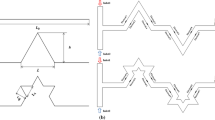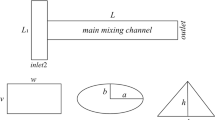Abstract
In this paper, a T-shape microchannel containing a mixing unit inserted in the straight main channel is designed to increase the mixing quality by geometrical changings in the mixing unit. Governing equations on flow field and concentration field have been discretized and solved using finite element method. Obtained numerical results were validated by comparing the numerical data reported in literature which show acceptable agreement. A MQ parameter based on the concentration variation of the mixture is employed to evaluate the mixing quality in the micromixer. The PI factor is also represented to check the increment in mixing quality with reference to hydraulic parameters. The effect of the number of mixing unit periods and curvature of the obstacles located in mixing unit on the MQ and PI factors have been investigated. The numerical results indicate that the type II gives better PI, so it has been chosen as the main case for the rest of study. On the other hand, the number of mixing unit periods was increased up to 25 for the type II. The results show that the best mixing quality (85.8%) has been obtained when 25-period mixing unit has been used. Also, noticeable mixing quality (81.2%) has been achieved for blood as working fluid using the proposed micromixer which could make it suitable for all chemical systems.













Similar content being viewed by others
Abbreviations
- C :
-
Concentration (mol/m3)
- D :
-
Diffusion coefficient (m2/s)
- J :
-
Mass flux (kg/m2s)
- MQ :
-
Mixing quality
- N :
-
Power law index
- P :
-
Pressure (Pa)
- PI :
-
Performance index
- \(\Delta P\) :
-
Pressure difference (Pa)
- V :
-
Velocity (m/s)
- \(\dot{\gamma }\) :
-
Shear rate (1/s)
- \(\lambda\) :
-
Relaxation time (s)
- \(\mu\) :
-
Dynamic viscosity (Pa s)
- \(\mu_{0}\) :
-
Zero shear-rate viscosity (Pa s)
- \(\mu_{\infty }\) :
-
Infinite shear-rate viscosity (Pa s)
- \(\rho\) :
-
Density (kg/m3)
- \(\sigma\) :
-
Variation of the concentration in mixture (mol/m3)
- i :
-
ith species of the mixture
- mean :
-
Mean value
- max :
-
Maximum value
References
Baheri Islami S, Khezerloo M (2017) Enhancement of mixing performance of non-Newtonian fluids using curving and grooving of microchannels. J Appl Fluid Mech 10:127–141
Bau HH, Zhong J, Yi M (2001) A minute magneto hydro dynamic (MHD) mixer. Sens Actuators B 79:207–215
Bouttausci F, Mezic I, Meinhart CD, Cardonne C (2004) Mixing in the shear superposition micromixer: three-dimensional analysis. Philo Transac: Mathe, Phys and Engi Sci 362:1001–1018
Chakraborty S (2005) Dynamics of capillary flow of blood into a microfluidic channel. Lab Chip 5:421–430
Chen CK, Cho CC (2007) Electro-kinetically-driven flow mixing in microchannels with wavy surface. J Colloid Interface Sci 312:470–480
Chen C, Cho C (2008) A combined passive/active scheme for enhancing the mixing efficiency of microfluidic devices. Chem Eng Sci 63:3081–3087
Cho A, Young I, Kensey KR (1991) Effects of the non-Newtonian viscosity of blood on flows in a diseased arterial vessel. Part 1: steady flows. Biorheology 28:241–262
Das SS, Tilekar SD, Wangikar SS, Patowari PK (2017) Numerical and experimental study of passive fluids mixing in micro-channels of different configurations. Springer, Cham
Fang Y, Ye Y, Shen R, Zhu P, Guo R, Hu Y, Wu L (2012) Mixing enhancement by simple periodic geometric features in microchannels. Chem Eng J 187:306–310
Goullet A, Glasgow I, Aubry N (2006) Effects of microchannel geometry on pulsed flow mixing. Mech Res Commun 33:739–746
Hsiao KY, Wu CY, Huang YT (2014) Fluid mixing in a microchannel with long vortex generators. Chem Eng J 235:27–36
Johnston BM, Johnston PR, Corney S, Kilpatrick D (2004) Non-Newtonian blood flow in human right coronary arteries: steady state simulations. J Biomech 37(5):709–720
Karthikeyan K, Sujatha L, Sudharsan NM (2017) Numerical modeling and parametric optimization of micromixer for low diffusivity fluids. Int J Chem Reactor Eng
Kim BJ, Yoon SY, Lee KH, Sung HJ (2009) Development of a microfluidic device for simultaneous mixing and pumping. Exp. Fluids 46:85–95
Kim BS, Kwak BS, Shin S, Lee S, Kim KM, Jung HI, Cho HH (2011) Optimization of micro scale vortex generators in a microchannel using surface method. Int J Heat Mass Transf 54(1):118–125
Kröger R (2006) CFD for microfluidics. Fluent Deutschland GmbH, Darmstadt
Lee CY, Chang CL, Wang YN, Fu LM (2011) Microfluidic mixing: a review. Int J Mol Sci 12:3263–3287
Lim CY, Lam YC, Yang C (2010) Mixing enhancement in microfluidic channel with a constriction under periodic electro-osmotic flow. Bio-microfluidics. 4:014101
Liu RH, Stremler MA, Sharp KV, Olsen MG, Santiago JG, Adrian RJ, Aref H, Beebe DJ (2000) Passive mixing in a three dimensional serpentine microchannel. J Microelectromech Syst 9:190–197
Liu RH, Lenigk R, Druyor-sanchez RL, Yang J, Grodzinski P (2003) Hybridization enhancement using cavitation microstreaming. Anal Chem 75:1911–1917
Mao WB, Xu JL (2009) Micromixing enhanced by pulsating flows. Int J Heat Mass Transf 52:5258–5261
Miranda JM, Oliveira H, Teixeira JA, Vicente AA, Correia JH, Minas G (2010) Numerical study of micromixing combining alternate flow and obstacles. Int Commun Heat Mass Transf 37:581–586
Nguyen NT, Wu Z (2005) Micromixers-a review. J Micromech Microeng 15:R1–R16
Oddy MH, Santiago JG, Mikkelsen JC (2001) Electrokinetic instability micromixing. Anal Chem 73:5822–5832
Ortega-Casanova J (2016) Enhancing mixing at a very low Reynolds number by a heaving square cylinder. J Fluids Struct 65:1–20
Ortega-Casanova J (2017) Application of CFD on the optimization by response surface methodology of a micromixing unit and its use as a chemical microreactor. Chem Eng Process 117:18–27
Samuel K, George M (2003) Whiteside, microfluidic devices fabricated in poly (dimethylsiloxane) for biological studies. Electrophoresis 24:3563–3576
Shamloo A, Mirzakhanloo M, Dabirzadeh MR (2016) “Numerical Simulation for efficient mixing of Newtonian and non-Newtonian fluids in an electro-osmotic micro-mixer. Chem Eng Process- Process Intensi 107:11–20
Somashekar V, Olse M, Stremler MA (2009) Flow structure in a wide microchannel with surface grooves. Mech Res Commun 36:125–129
Stone HA, Kim K (2001) Microfluidics: basic issues, applications, and challenges. AIChE J 47(6):8
Stroock AD, Dertinger SK, Whitesides GM, Ajdari A (2002) Patterning flows using grooved surfaces. Anal Chem 74:5306–5312
Tsui YY, Yang CS, Hsieh CM (2008) Evaluation of the mixing performance of the micromixers with grooved or obstructed channels. J Fluids Eng 130:071102-1
Author information
Authors and Affiliations
Corresponding author
Additional information
Publisher's Note
Springer Nature remains neutral with regard to jurisdictional claims in published maps and institutional affiliations.
Rights and permissions
About this article
Cite this article
Fallah, D.A., Raad, M., Rezazadeh, S. et al. Increment of mixing quality of Newtonian and non-Newtonian fluids using T-shape passive micromixer: numerical simulation. Microsyst Technol 27, 189–199 (2021). https://doi.org/10.1007/s00542-020-04937-z
Received:
Accepted:
Published:
Issue Date:
DOI: https://doi.org/10.1007/s00542-020-04937-z




